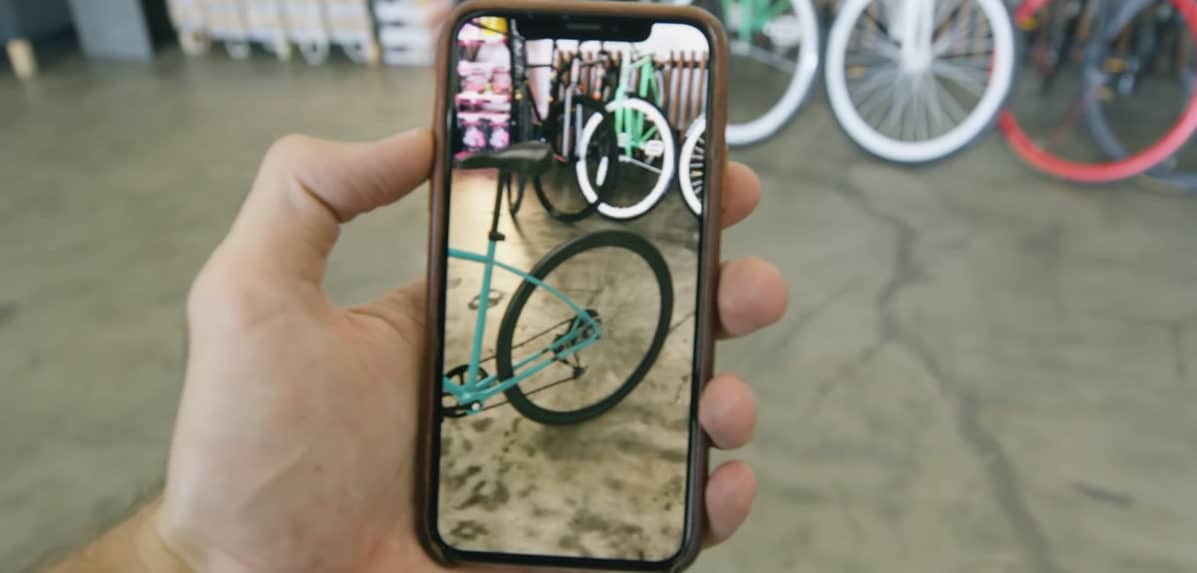
 XR Talks is a series that features the best presentations and educational videos from the XR universe. It includes embedded video, narrative analysis and top takeaways. Speakers’ opinions are their own. For a full library of indexed and educational media, subscribe to ARtillery PRO.
XR Talks is a series that features the best presentations and educational videos from the XR universe. It includes embedded video, narrative analysis and top takeaways. Speakers’ opinions are their own. For a full library of indexed and educational media, subscribe to ARtillery PRO.
Advertising continues to be a bright spot in AR’s otherwise-challenged early days. Brand spending on AR ads is on track reach $1.41 billion this year according to ARtillery Intelligence estimates, making this one of the most high-performing subsectors of the AR universe.
But the opportunity goes beyond advertising. AR will influence commerce through brands’ and retailers’ self-distributed apps for eCommerce and in-aisle retail experiences. This involves an expanding value chain from 3D product models to experience creation to distribution to analytics.
To make sense of it all, Shape Immersive ran a series of virtual events over the past few months. The takeaways were robust enough to devote a 3-part run of our weekly XR talks series, continuing here in part 2 with a new group of AR thought leaders (videos and takeaways below).

Let’s Get Figital
Picking up where we left off in part I, a new cast of characters weighs in on AR commerce’s future and its expanding value chain. An underlying theme here is thinking of AR as a technology to make digital media and eCommerce more physical, while making physical goods more digital.
We often think of AR as the former: product visualization in eCommerce contexts to boost consumer confidence. But it goes in the other direction too, as AR can bring physical goods to life with informational or narrative overlays — either in stores aisles or in Covid-safe locations.
“It’s the digitization of the physical and the physicality of the digital,” said 8th Wall’s Tom Emrich, a dual-modality known as figital. “I think that one of these huge elements when it comes to eCommerce is making the online shopping experience feel more physical.”
All of the above is prooving out in terms of AR campaign metrics, as we continue to examine. Shopify’s Daniel Beauchamp reiterates the business case through hard numbers that Shopify merchants are seeing after integrating the company’s AR Quick Look feature.
This includes up to 2.5x greater likelihood in shopper conversions for merchants that applied AR visualization. In a separate case study for Rebecca Minkoff handbags on Shopify, 65 percent of people who used AR were more likely to add to cart, and 62 percent were more likely to purchase.
“We were actually quite surprised by just how well AR has been working for our merchants,” said Beauchamp. “It’s a boost in conversions with our most recent launch, which was true native support of 3D on Shopify so you can just drag and drop 3D models right onto your product page.”
Merchant-Facing
As explored in part I, AR has the potential to transform B2B functions in addition to consumer-facing ones. That includes the “shopping” that retailers do to (a la corporate buyers) to supply their stores. This gains relevance in the Covid-era says VNTANA‘s Ashley Crowder.
“Our apparel clients are not just using this for consumer-facing sites but they’re actually creating digital showrooms for buyers,” she said. “Obviously Covid has stopped all sales travel and prevented getting prototypes into the hands of those buyers, so it’s not only lifting that consumer purchase, but it’s also lifting that buyer.”
Adding to the merchant-facing benefits, Beauchamp says that it’s all about “configurability.” When dealing with products that have lots of variability or customization — such as bicycles — giving consumers a virtual way to configure things can have merchant inventory and cash flow benefits.
“I remember speaking to an owner of a road bike store in Toronto that sells these ten-thousand-dollar racing bicycles,” said Beauchamp. “You can customize everything down to the little knob that you put air in your tires […] If you could just walk into that store and be handed a tablet where you pick your colors and everything; and see the exact bike you’re about to purchase as it will look in real life[,] that’s powerful, and not only beneficial to the customer: The merchant might not need a huge warehouse anymore.”
Lastly, AR can work towards just-in-time inventory systems which likewise bring cost efficiencies to consumer products. By testing demand signals for products using AR visualization, it creates a more efficient feedback loop to inform consumer goods companies’ design and manufacturing.
“It’s about getting feedback as early and as quickly as possible,” said Beauchamp. “Imagine doing a Kickstarter campaign for some product, but now you can actually just say ‘Hey, place this thing that doesn’t exist yet in your home and give us feedback. […] That ability to magically teleport a product that doesn’t exist yet into people’s hands is something that retailers have never been able to do.”
Missing Piece
For all of the above to materialize, one missing piece is ubiquitous 3D asset creation. Early adopter brands like IKEA have achieved this in-house. But what the market really needs is something scalable and cost-efficient for large retailers and SMBs to scan their products.
We’re getting there, says Beauchamp, including low-friction and SMB-friendly offers from CG Trader and others. Some can even build a rudimentary 3D model from 2D photos that you send them. But there’s still a ways to go before 3D models reach the ubiquity of digital photography.
The strategy is to commit to AR in order to amortize that investment over time, as we’ve examined. Once a 3D model is created, that fixed cost can be realized against several other uses beyond AR lenses. For example, Emrich envisions digital product placement in influencer videos.
“How much value can you get from that investment in a 3D object should be the question that you’re asking,” said Emrich. “It’s the same way you’d be asking yourself, ‘Okay, I just invested X amount on this video: Where can I put it? on TV? Can I use it in a keynote? Can I send it in an email blast? […] I see this all coming together in the influencer economy as well, by equipping influencers with 3D objects they can put into their scenes.”
It’s also about breaking down organizational silos, says Crowder. In some cases, brands don’t even know they have 3D assets. If they manufactured a product, that 3D design file exists somewhere… so it’s all about aligning organizational goals for a holistic AR effort.
“This is like the 80’s when we went from film to digital. We are now moving from digital to CGI,” said Crowder. “So really look at your business and connect the silos. […] Having that one 3D asset from design to sales to advertising can save so much time and money.”
See the full roundtable discussion below, including moderation by HTC’s Amy Peck.


